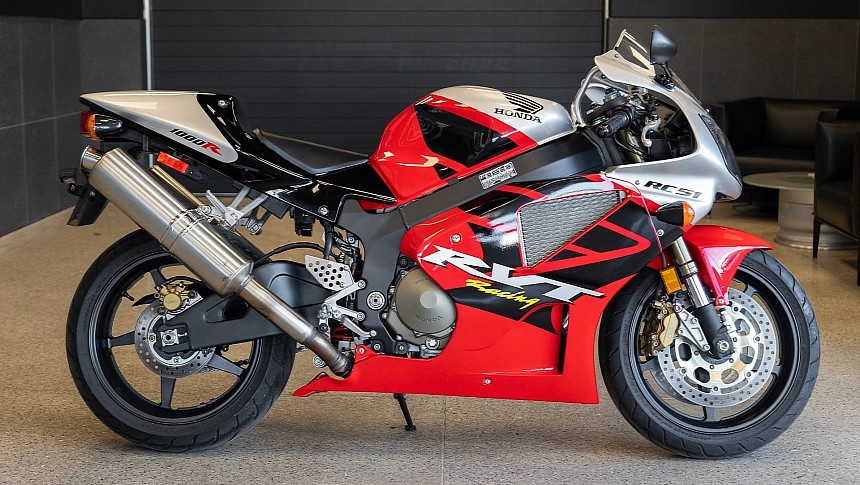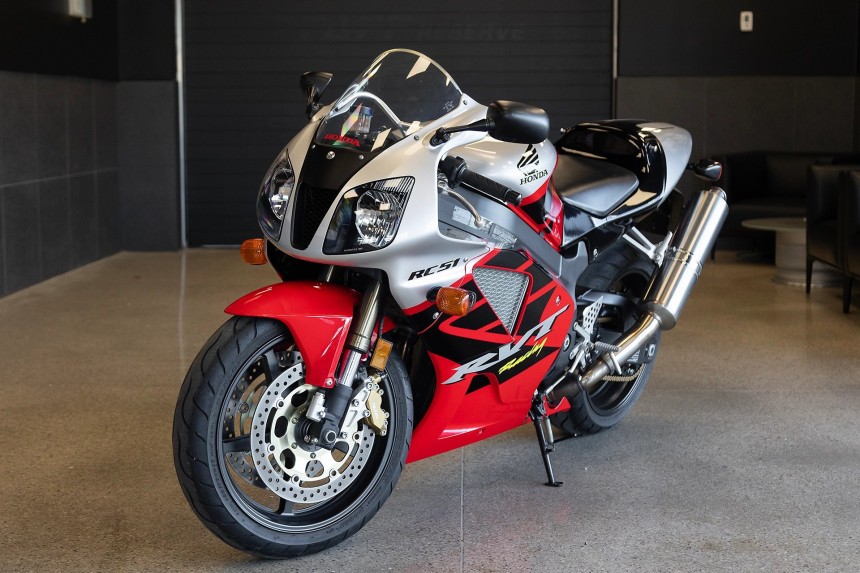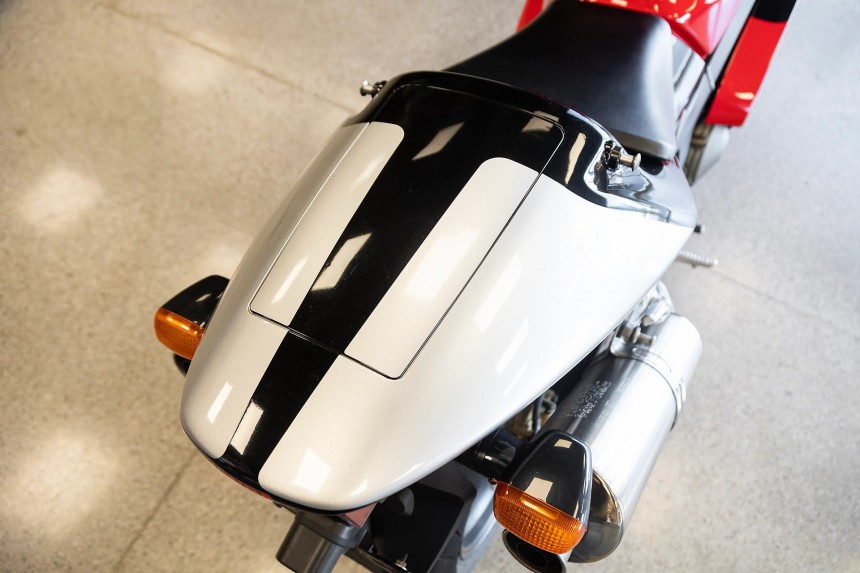Born to challenge Ducati’s dominance in World Superbike racing, the Honda RC51 was a true legend of its era. Americans know it primarily as the RVT1000R, but the name VTR1000 SP1 (and later SP2) may sound more familiar if you’re from Europe or Australia.
The motorcycle debuted in the year 2000 following a decade of Italian supremacy, which saw Ducati snatching as many as eight championship victories. Obviously, Honda needed to go back to the drawing board if they were to stand a chance against Bologna’s fierce L-twins.
Oh, and the fact that the RC45’s homologation period was coming to an end in 1999 only gave them another reason to get creative, and get creative they did! In case you’re familiar with WSBK history, then you certainly know what happened next. The RC51 was developed with heavy input from HRC engineers, gaining a 999cc V-twin powerplant that would prove to be way more competitive than its predecessor’s 749cc V4.
It enabled Colin Edwards to win the WSBK Riders’ Championship the same year it was introduced, while Nicky Hayden lost the AMA Superbike title to Suzuki rider Mat Mladin by a mere five points. Ducati still took the Manufacturers’ Championship in WorldSBK for the 2000 season, but Honda’s titan made it abundantly clear that it was a force to be reckoned with.
Colin Edwards took home another Riders’ title battling Troy Bayliss in 2002, the same year Hayden reigned supreme as AMA Superbike champion. Unfortunately, Honda withdrew factory support for WorldSBK teams after that season. In part, this decision came as a result of rule changes welcoming 1,000cc four-cylinder engines on the grid, thus removing the 250cc displacement advantage V-twins had up until then.
The Japanese manufacturer also wished to focus solely on MotoGP, so the fate of their superbike racing efforts was sealed and it would stay that way for nearly two decades. As for the RVT1000R, it made way for the inline-four CBR1000RR Fireblade on the track in Honda’s absence, but road-going models continued to be produced until 2006.
They were something of a bargain, too, at least compared to the ultra-limited RC45s that came before. Whereas the latter’s MSRP stood at an eye-watering $27k, the RC51 in its first model-year could be yours for a mere ten grand. Pricing did increase gradually over time, though, reaching $11,999 for the final 2006 iteration.
Still, that’s less than half the price of an earlier RC45, and the difference is even more startling when you take a little thing called inflation into account. Besides this, one must also consider the performance side of the equation, as the SP2 variant introduced in 2002 brought several upgrades to the table.
Improved throttle response was made possible thanks to new injectors, revised fuel mapping, and bigger 62 mm (2.4-inch) throttle bodies. An additional radiator fan solved overheating problems, while reduced rake and trail worked in conjunction with a longer swingarm to refine the machine’s handling characteristics. Its V-twin stable gained a few extra ponies, and total weight became just a tad lower in the process.
By spawning 136 hp right below its 10k-rpm redline, the engine could bring about a top speed of around 165 mph (265 kph). The RC51’s Pro-Link rear suspension system and adjustable 43 mm (1.7-inch) upside-down forks are certainly decent, though top-shelf aftermarket replacements are the preferred way to go for those who can afford it.
For stopping power, Honda’s beast uses Nissin calipers to pinch dual 320 mm (12.6-inch) floating rotors up north and a single 220 mm (8.7-inch) disc at the other end. With an empty tank of gas, the updated RVT1000R would tip the scales at just under 430 pounds (195 kg). That being said, let’s talk more specifically about the pristine exemplar displayed in this article’s photo gallery.
It’s a 2003 model currently located in Ontario, Canada, and still in the original owner’s possession after all these years. Taking a look at the bike’s digital odo, we find that it has only 766 kilometers (476 miles) under its belt, so it spent more time as a fancy ornament rather than a street-legal track weapon.
In any case, it appears to have been taken care of like a precious gemstone, and it could end up in your garage if you act swiftly! That’s right; the RC51 in question is currently making its way to auction on Bring a Trailer, with no reserve price set by the seller and a top bid of $10,000 at the time of this article.
The bidding process is going to end on Thursday afternoon (July 12, 2023), so be sure to get in on the action within the next few days in case you’re interested. Having said that, we wouldn’t expect the leading offer to remain at $10k for much longer given the specimen’s excellent condition, but who knows?
Oh, and the fact that the RC45’s homologation period was coming to an end in 1999 only gave them another reason to get creative, and get creative they did! In case you’re familiar with WSBK history, then you certainly know what happened next. The RC51 was developed with heavy input from HRC engineers, gaining a 999cc V-twin powerplant that would prove to be way more competitive than its predecessor’s 749cc V4.
It enabled Colin Edwards to win the WSBK Riders’ Championship the same year it was introduced, while Nicky Hayden lost the AMA Superbike title to Suzuki rider Mat Mladin by a mere five points. Ducati still took the Manufacturers’ Championship in WorldSBK for the 2000 season, but Honda’s titan made it abundantly clear that it was a force to be reckoned with.
Colin Edwards took home another Riders’ title battling Troy Bayliss in 2002, the same year Hayden reigned supreme as AMA Superbike champion. Unfortunately, Honda withdrew factory support for WorldSBK teams after that season. In part, this decision came as a result of rule changes welcoming 1,000cc four-cylinder engines on the grid, thus removing the 250cc displacement advantage V-twins had up until then.
They were something of a bargain, too, at least compared to the ultra-limited RC45s that came before. Whereas the latter’s MSRP stood at an eye-watering $27k, the RC51 in its first model-year could be yours for a mere ten grand. Pricing did increase gradually over time, though, reaching $11,999 for the final 2006 iteration.
Still, that’s less than half the price of an earlier RC45, and the difference is even more startling when you take a little thing called inflation into account. Besides this, one must also consider the performance side of the equation, as the SP2 variant introduced in 2002 brought several upgrades to the table.
Improved throttle response was made possible thanks to new injectors, revised fuel mapping, and bigger 62 mm (2.4-inch) throttle bodies. An additional radiator fan solved overheating problems, while reduced rake and trail worked in conjunction with a longer swingarm to refine the machine’s handling characteristics. Its V-twin stable gained a few extra ponies, and total weight became just a tad lower in the process.
By spawning 136 hp right below its 10k-rpm redline, the engine could bring about a top speed of around 165 mph (265 kph). The RC51’s Pro-Link rear suspension system and adjustable 43 mm (1.7-inch) upside-down forks are certainly decent, though top-shelf aftermarket replacements are the preferred way to go for those who can afford it.
It’s a 2003 model currently located in Ontario, Canada, and still in the original owner’s possession after all these years. Taking a look at the bike’s digital odo, we find that it has only 766 kilometers (476 miles) under its belt, so it spent more time as a fancy ornament rather than a street-legal track weapon.
In any case, it appears to have been taken care of like a precious gemstone, and it could end up in your garage if you act swiftly! That’s right; the RC51 in question is currently making its way to auction on Bring a Trailer, with no reserve price set by the seller and a top bid of $10,000 at the time of this article.
The bidding process is going to end on Thursday afternoon (July 12, 2023), so be sure to get in on the action within the next few days in case you’re interested. Having said that, we wouldn’t expect the leading offer to remain at $10k for much longer given the specimen’s excellent condition, but who knows?






























